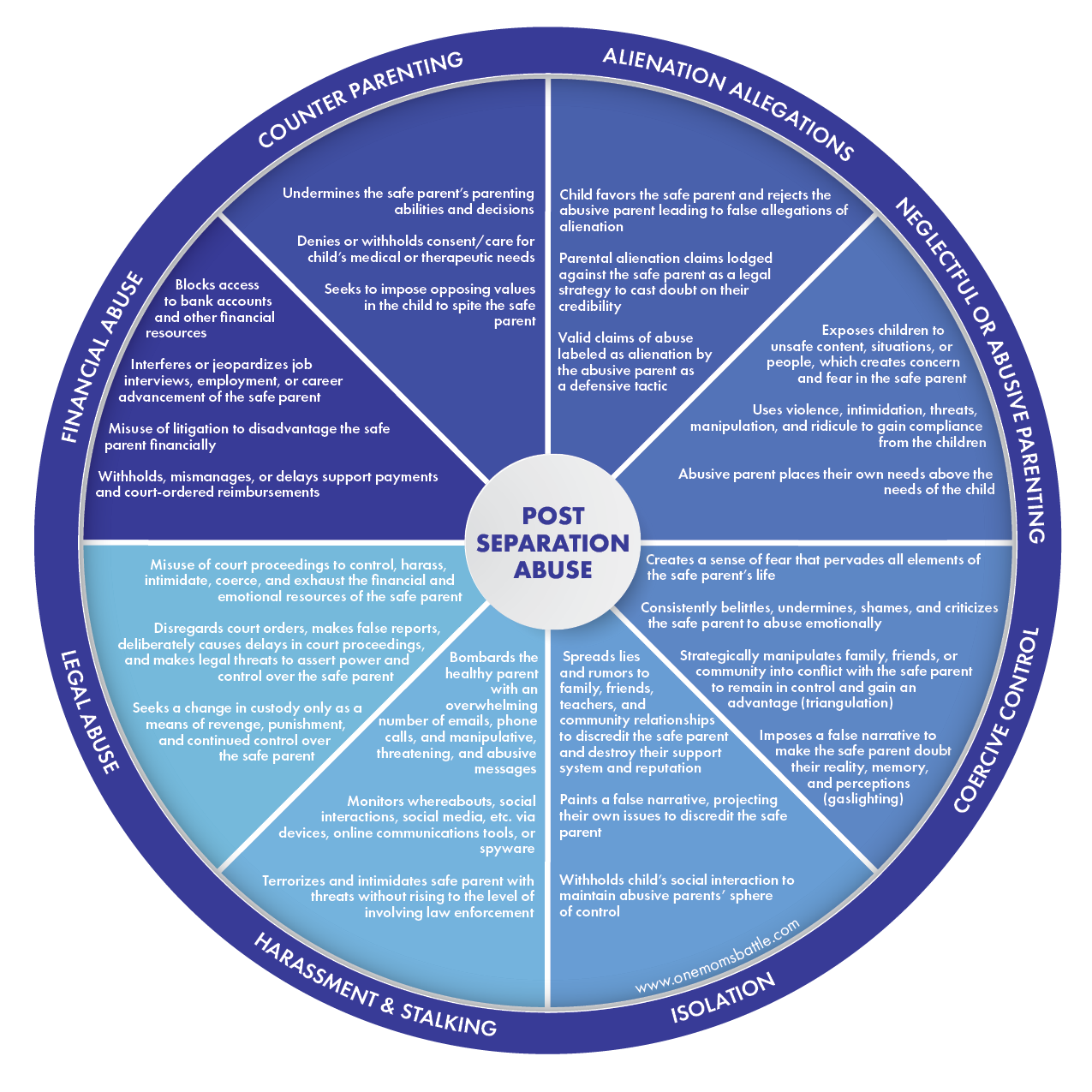Post Seperation Abuse
Leaving an abusive marriage or relationship is complicated. Deciding to separate and or divorce anyone you’ve been in a long-term relationship with is difficult, add children to the equation family court becomes even more convoluted. On top of that add in high conflict personalities and this already awful time in someone’s life becomes traumatic for the healthy spouse and protective parent. I know for me, on my wedding day I sure wasn’t thinking “Oh boy, I cannot wait to have children build a life and then get divorced, spending years of my life in litigation and having our child dragged into the chaos of long, often purposely dragged-out S**tshow that is Family Court.
Individuals that have bravely taken the steps to leave an abusive situation innocently walk into family court expecting this institution to protect them and their children only to realize the very institution that’s meant to protect them is weaponized by the abuser to torment and continue the abuse post separation.
Understanding what post-separation abuse is, what tactics the abuser uses and what help is available is important for anyone dealing with physical, emotional, psychological, sexual or narcissistic abuse.
What Is Post-Separation Abuse?
It’s estimated 90% of all people that have suffered coercive control abuse at the hands of their partners go on to experience post-separation abuse after they leave**(Domesticshelters.org)
The term refers to coercive and controlling behaviors that continue after the couple separates. An abusive spouse often resorts to these behaviors to frighten and coerce their partners to return or to punish them by making divorce and custody proceedings as difficult as possible.
Post Separation Abuse Tactics
The Post- Separation abuse wheel below is a model that abuse experts use to explain the eight main tactics of Post-Separation Abuse. These Tactics include.
· Alienation allegations: Children living in a household where domestic violence occurs often favor the abused parent over the abusive one. When this happens, the abuser may claim that their spouse is purposefully alienating them from the children. They do so to undermine the abused spouse's credibility to defend inappropriate or abusive behavior.
· Neglectful parenting: The abusive spouse may use children as a weapon to intimidate and threaten their partner by exposing kids to unsafe situations or inappropriate content. They put their own needs above the safety and well-being of their children and may even become abusive toward their children to regain control.
· Coercive control: The abusive spouse may begin or continue with coercive control tactics, such as criticizing, shaming, and tearing down their partners to try to force them to live in fear. Gaslighting or creating a false story to make someone doubt themselves may also be employed in an attempt to make the abused spouse question whether they were right to leave.
· Isolation: The abuser seeks to remove any family, friend, and community support the abused spouse has by making up lies and rumors. Their efforts may include preventing their children from seeing these individuals so their story can be maintained.
· Harassment and stalking: The abuser sends an overwhelming number of emails or texts or makes repeated phone calls to communicate threatening and manipulative messages. They may also use social media or spyware to track the movements of the abused spouse and show up in places as a sign that they can get to them anywhere.
· Legal abuse: An abusive person may begin using the family court system to abuse a spouse. They may make false claims, delay court proceedings and ignore court orders to reestablish their power. Fighting for custody of children and making false testimony about the abused spouse is a common tactic in legal abuse. However, abusers without children can also use the divorce or family court system to intimidate and harass their partners.
· Financial abuse: The abuser makes it impossible or difficult for their spouse to access money in their bank accounts. If there are separate accounts, they may instead try to get their spouse fired so that they will lose their means of financial support. If the court orders support payments, the abuser may refuse to pay.
· Counter parenting: The abuser uses children to undermine their spouse. They may do so by criticizing the other parent's skills or refusing to consent to their kids' medical and mental health treatments. Raising children with morals and values counter to the abused spouse's is another form of counter-parenting
Courts all over the country are still allowing perpetrators of this type of control and torment to happen at an alarming rate to victims, often through the children. Family court judges are still failing to identify patterns of controlling and coercive behavior.
From what I’ve personally seen over the past few years there are more court professionals like lawyers and Guardian Ad Litems that are starting to take an interest in this subject and still, very few, but some none the less are starting to educate their clients and or colleagues of this massive injustice and manipulation perpetrated by the abuser.
If you or a loved one is experiencing Post-Separation Abuse hiring a Certified High Conflict Divorce Coach can be a valuable collaborator in your corner A High Conflict Divorce and Custody Coach has been in your shoes and can help advocate for you and your children. Trained and experienced coaches can also help spot instances of post separation abuse that you may not be aware of, we’ve been trained to think logically when our clients may not be able to put all the pieces together on their own just yet. Having a coach will not stop an abusers behavior but we are here as a support, our goal for you s to feel more empowered and strong throughout your high conflict court proceedings.
Please Reach Out!


